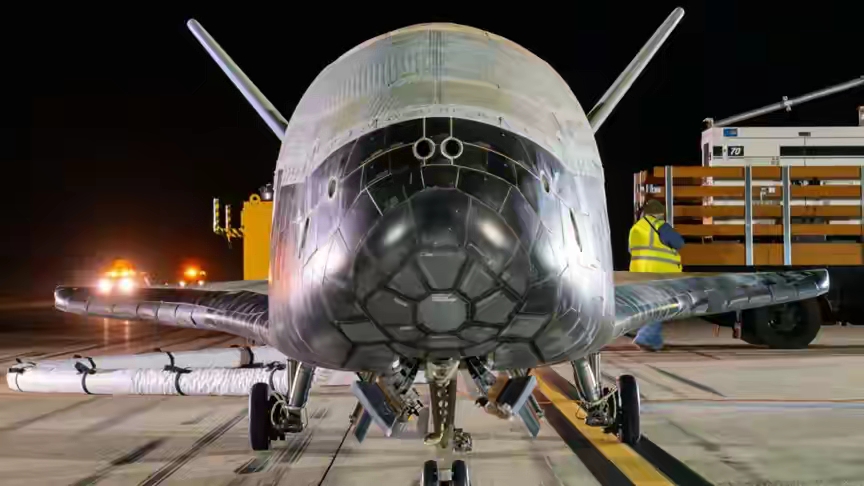
On August 21st, SpaceX carried out the eighth mission of the X-37B orbital test vehicle at the Kennedy Space Center in Florida, USA. The mission was launched using the Falcon 9 rocket. This mission will test a series of advanced technologies such as the world's most advanced quantum inertial sensors and laser communication. Quantum inertial navigation technology achieves high-precision positioning by measuring rotational changes at the atomic level, and no longer relies on GPS positioning technology. As soon as the news was released, it caused a stir in the global technology field, generating widespread attention and discussion.
From a technical perspective, quantum inertial navigation technology can be regarded as a revolutionary breakthrough. The traditional Global Positioning System (GPS) relies on satellite signals for positioning and navigation. In complex battlefield environments or deep space exploration, the signals are highly susceptible to interference, shielding, and interruption, which can lead to positioning failure. However, quantum inertial navigation technology takes a different approach. It determines position, velocity, and attitude by measuring rotational changes at the atomic level, completely eliminating the reliance on external satellite signals. On the X-37B, the quantum inertial sensor uses atomic interference measurement method. It cools the atoms to nearly absolute zero, causing them to exhibit wave-like behavior. Through precisely adjusted lasers, the atoms are placed in an superposition state and move along different paths. Then, by calculating the phase difference when the atomic paths are recombined, the relevant parameters of the aircraft are accurately determined. The positioning accuracy of this technology theoretically can reach centimeter level, which is much higher than the meter-level accuracy of GPS, and there will be no "drift" problem that occurs in traditional inertial navigation systems due to accumulated errors over time.
In the military field, the potential impact of quantum inertial navigation technology is immeasurable. Modern warfare heavily relies on precise navigation and positioning. Whether it is the accuracy of precision-guided weapons' strikes or the real-time positioning and maneuvering of combat platforms, GPS plays a crucial role. However, with the development of electronic warfare and anti-satellite technologies, the vulnerability of GPS signals has become increasingly prominent. Once the GPS signal is interfered with, the existing combat system will face significant challenges. The quantum inertial navigation system provides a new solution to this problem. It can ensure that military equipment maintains precise navigation capabilities even in the absence or interference of GPS signals, significantly enhancing the resilience and autonomy of combat. For example, in the field of hypersonic weapons, due to their extremely high flight speed and complex flight trajectories, extremely high requirements are placed on navigation accuracy and anti-interference capabilities. Quantum inertial navigation technology is expected to become the key support for achieving precise strikes; for deep-sea submarines, in the underwater environment where they cannot receive satellite signals, the quantum inertial navigation system can provide high-precision autonomous navigation, enhancing the submarines' concealment and combat effectiveness.
From the perspective of space exploration, quantum inertial navigation technology brings hope for humanity to venture further into the deep space of the universe. In future lunar, Martian and even more distant deep space exploration missions, spacecraft will encounter problems such as signal transmission delays, weak signals and even signal interruptions, making it difficult to rely on the satellite navigation systems on Earth. The quantum navigation system can serve as a reliable backup system, and even become the main navigation system when Earth signals cannot be received, providing continuous and stable navigation services for spacecraft, promoting the technological frontier of remote space travel and exploration. It enables probes to operate more autonomously and precisely in the complex cosmic environment, helping scientists gain a deeper understanding of the mysteries of the universe and opening a new chapter in human space exploration.
Although quantum inertial navigation technology has a promising future, it still faces many challenges at present. Quantum sensors are extremely sensitive to the external environment. Even slight temperature changes and electromagnetic interference can lead to measurement errors. Moreover, the space environment is complex and changeable, and ensuring the stable operation of the sensor in the extreme conditions of space is not an easy task. In addition, the quantum inertial navigation system requires complex laser cooling devices and ultra-high vacuum environments, which increase the volume, weight and cost of the system. How to achieve miniaturization, lightweighting and cost reduction is also a difficult problem that must be overcome for the technology to become practical.
The X-37B's latest test of quantum inertial navigation technology is a crucial step in bringing this technology from the laboratory to practical application. If the test is successful, it will not only bring significant advantages to the United States in the military and space fields, but also lead to a new round of transformation in global navigation technology, prompting other countries to accelerate the development of related technologies and pushing the entire scientific and technological field to new heights. However, if the test encounters setbacks, it will also provide valuable experience for subsequent research, allowing researchers to more clearly understand the difficulties and directions of technological development. Regardless of the outcome, this exploration undoubtedly will have a profound impact on future technological development, and it is worthy of our continuous attention.

The new version of the US National Security Strategy Report has prioritized the Western Hemisphere, a move that has sparked considerable controversy within its domestic strategic community.
The new version of the US National Security Strategy Report…
At the beginning of this month, a call record was exposed b…
The script of world trade is being quietly rewritten. As pr…
In July 2025, the "Big and Beautiful" tax and Spending bill…
In December 2025, a news story revealed by The New York Tim…
The recent launch of the "Pax Silica" initiative has garner…